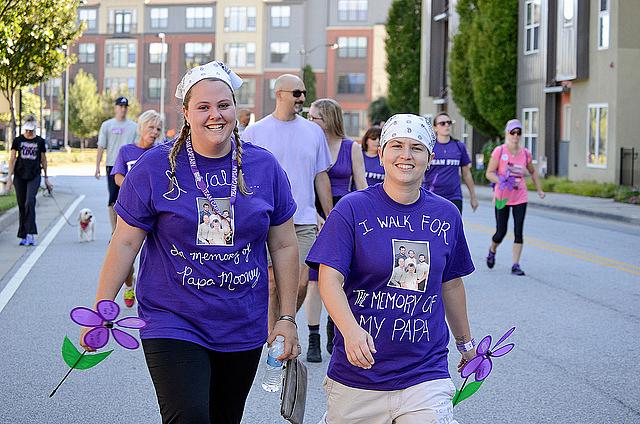For Families Dealing With Alzheimer’s, the Need for More Research Is Clear

Participants in a 2013 walk to end Alzheimer's in Atlanta, Georgia.
I always thought that Dad would keep urging me, “Go get those Republicans!” long after Alzheimer’s stole his memory of my name. Now I don’t know. He doesn’t talk about politics any more. His favorite topic of conversation during my whole life has disappeared.
He still has the ability, honed during the years of being county chairman, to smile and converse and fake it, even if he doesn’t remember someone’s name. So sometimes he knows me and sometimes he doesn’t and sometimes it just doesn’t matter.
Alzheimer’s disease is winning, but Dad is still fighting the good fight. He pretends to run down the hall of the nursing home with his walker. He teases Mother. His sense of humor does battle with the darkness, and often manages to shine through.
Dad is one of an estimated 5.2 million people in the United States with Alzheimer’s disease. According to a new report released March 18 by the Alzheimer’s Association, one in nine Americans over the age of 65 have Alzheimer’s disease. In Minnesota, where I live, an estimated 88,000 people have Alzheimer’s in 2014, and that number is projected to increase to 120,000 by 2025 — a 36 percent increase. (All numbers in this post come from the 2014 Alzheimer's Report.)
Almost two-thirds of those who have Alzheimer’s are women. Older African American people are more likely to have Alzheimer’s than older white people. Far more women than men are caregivers for a family member with Alzheimer’s. Women are 65 percent of all unpaid caregivers for people with Alzheimer’s and, according to the report, “the value of informal care was nearly equal to the direct medical and long-term care costs of dementia.” That’s a huge burden, especially since many of the caregivers themselves are over 65. The report says that, “Seventy-four percent of caregivers of people with Alzheimer’s disease and other dementias reported that they were ‘somewhat concerned’ to ‘very concerned’ about maintaining their own health since becoming a caregiver.”
Though the facts and figures in the report can’t assuage the pain of the disease in our family, or in any other family living with Alzheimer’s, they may point the way to help in the future. Focusing attention on a disease increases research, and that makes a difference. From 2000 to 2010, deaths from heart disease decreased by 16 percent; deaths from stroke by 23 percent; deaths from HIV by 42 percent. During the same time period, deaths from Alzheimer’s increased by 68 percent.
Research makes the difference. Research finds ways to diagnose diseases, ways to prevent them, ways to treat them.
Right now, there is no way to prevent Alzheimer’s disease and no way to cure it. There are drugs and non-drug treatments that can temporarily help with symptoms.
Ongoing clinical trials are testing many more potential treatments. Recent research has also improved early diagnosis of Alzheimer’s, which can give time to plan and prepare for life with the disease, and the opportunity to participate in clinical trials. Investing in research is not only the right thing to do — it also makes economic sense for an aging America to try to reduce the incidence of a very expensive disease.
Dad has not lost the courage to laugh, although at times the darkness wins. Even though none of this research is going to help Dad, or the millions of other people with late stage Alzheimer’s disease, we must muster the courage to fight, to support research, to work for hope for coming generations. Research has helped to beat down other diseases and one day it will find ways to prevent and treat Alzheimer’s disease.
This post was originally published on the blog News Day.
Photo by Susuma Komatsu via Flickr.
